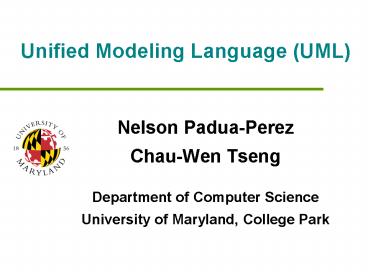Unified Modeling Language UML - PowerPoint PPT Presentation
1 / 28
Title:
Unified Modeling Language UML
Description:
Unified Modeling Language (UML) Nelson Padua-Perez. Chau-Wen Tseng ... Depicts selected aspects of a model using set of diagrams. Diagram ... – PowerPoint PPT presentation
Number of Views:84
Avg rating:3.0/5.0
Title: Unified Modeling Language UML
1
Unified Modeling Language (UML)
- Nelson Padua-Perez
- Chau-Wen Tseng
- Department of Computer Science
- University of Maryland, College Park
2
Overview
- Unified Modeling Language (UML)
- Models views
- Class diagrams
- Sequence diagrams
3
UML
- UML (Unified Modeling Language)
- Graphic modeling language for describing
object-oriented software - Started in 1994
- Combined notations from 3 leading OO methods
- OMT (James Rumbaugh)
- OOSE (Ivar Jacobson)
- Booch (Grady Booch)
4
UML Motivation
- Software growing larger complex
- Difficult to analyze
- Need to describe software design
- Clearly
- Concisely
- Correctly
- UML equivalent to software blueprint
- Provides simple yet clear abstraction for
software - Computer-aided software engineering (CASE)
- Tools for generating analyzing UML
5
Definitions
- Model
- Abstraction describing (all or part of) system
- View
- Depicts selected aspects of a model using set of
diagrams - Diagram
- Actual depiction of aspect of model
- Notation
- Set of graphical / textual rules for representing
view
6
Models Views
System
Model 1
View 1
View 2
View 3
Model 2
7
UML
- Industry standard
- Many features
- Large collection of notations
- Multiple views
- Multiple diagrams
- We focus mainly on
- Logical view of relationship between classes
8
UML Views
- Use-Case
- Show external user (actor) view of system
- Logical
- Show how functionality is implemented
- Component
- Show organization of code components
- Deployment
- Show assignment of code to physical computers
9
(Some) UML Diagrams
- Class
- Describe static structure of the classes in
system - Sequence
- Describe dynamic behavior between users and
objects - Use case
- Describe functional behavior seen by (external)
user - State
- Describe dynamic behavior of objects as finite
state machine - Activity
- Model dynamic behavior of a system as a flowchart
10
UML Conventions
- Rectangles ? classes or instances
- Ovals ? functions or use cases
- Types ? preceded by colon, not underlined
- SimpleWatch
- Instances ? underlined names
- myWatchSimpleWatch
- Diagrams ? graphs
- Nodes ? entities
- Arcs ? relationships between entities
11
Class Diagrams
12
Sequence Diagram
Object
Message
Activation
Sequence diagrams represent behavior as
interactions
13
Use Case Diagrams
Package
SimpleWatch
Actor
ReadTime
SetTime
WatchUser
WatchRepairPerson
Use case
ChangeBattery
Use case diagrams represent functionality of
system from external users point of view
14
State Diagrams
State
Initial state
Event
Transition
button12Pressed
Final state
15
UML Sequence Diagrams
- Represent behavior in terms of interactions
- During requirements analysis
- Used to refine use case descriptions
- During system design
- Used to refine subsystem interfaces
16
Sequence Diagram Notation
- Columns ? Classes
- Arrows ? Messages
- Narrow rectangles ? Activations
17
Sequence Diagram Example
- Sequence of events for printer queue
18
UML Class Diagrams
- Represent the (static) structure of the system
- During analysis
- Used to model problem domain concepts
- During detailed design
- Used to model classes
19
Class Diagrams
- Class contains
- Name
- State
- Behavior
20
Class Diagrams
- Types may be included
- Only class name is required
21
Sequence Diagram Observations
- Represents behavior in terms of interactions
- Complement the class diagrams which represent
structure - Useful for finding participating objects
22
UML Class Diagrams ? Java Code
- Different representation of same information
- Name, state, behavior of class
- Relationship(s) between classes
- Should be able to derive one from the other
- Motivation
- UML ? Java
- Implement code based on design written in UML
- Java ? UML
- Create UML to document design of existing code
23
Java ? UML Clock Example
- Java
- class Clock // name
- // state
- int seconds
- int minutes
- int hours
- // behavior
- void start()
- void adjustTime()
- void reset()
Class Diagram
Java Code
24
Java ? UML Printing System
- Java
- class Job
- class Registry
- PrintQueue findQueue()
25
Java ? UML Printing System
- Java
- class PrintQueue
- List printJobs
- Printer myPrinter
- Registry myRegistry
- void newJob()
- int length()
- Resources getResource()
26
Java ? UML Printing System
- Java
- class Printer
- Resources myResources
- Job curJob
- void print()
- boolean busy()
- boolean on()
27
UML ? Java Printing System
- Java
- class Printer
- Resources myResources
- Job curJob
- void print()
- boolean busy()
- boolean on()
- UML
28
Summary
- Overview of UML
- Focus on class diagrams
- How they represent structure of software
- Conversion to/from Java
- Next lecture will examine
- How UML represents relationships between classes
- More UML ? Java conversions

